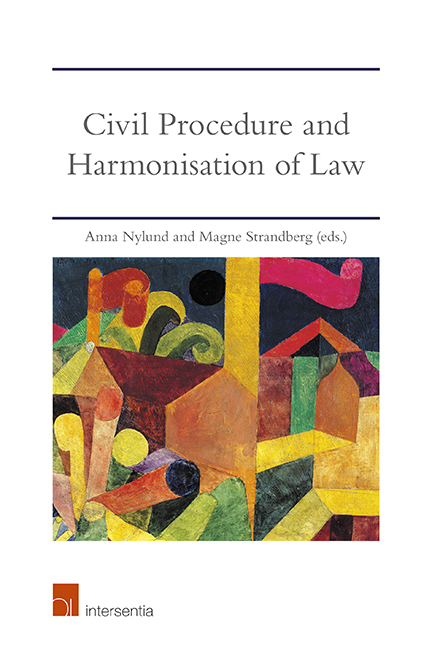Book contents
- Frontmatter
- Preface
- Contents
- List of Contributors
- List of Abbreviations
- Introduction
- EU Civil Justice at the Harmonisation Crossroads?
- The ELI-UNIDROIT Project: An Introduction and an English Perspective
- Europeanisation of Civil Procedure: Overcoming Follow-Up Fragmentation through Bottom-Up Harmonisation?
- Harmonisation or Fragmentation of National Law? An East Nordic Perspective
- An Examination of the Influence of European Union Law on English Civil Procedure
- The EU's Influence on Norwegian Civil Procedure through National Substantive Law
- Consumer Protection and EU-Driven Judicial Activism in the Netherlands
- The Role of the Judge in Consumer Cases – A German Perspective
- Ex Officio Application of the Unfair Terms Directive Cases against Consumers: A Swedish Perspective
- Ex Officio Application of EU Consumer Protection Law in Norwegian Courts
- Maintenance and Multi-Level Harmonisation: A European Union Perspective
- Family Maintenance and Multi-Speed Integration: A Norwegian Perspective
- Conclusions on Civil Procedure and Harmonisation of Law
- About the Editors
The EU's Influence on Norwegian Civil Procedure through National Substantive Law
Published online by Cambridge University Press: 30 March 2019
- Frontmatter
- Preface
- Contents
- List of Contributors
- List of Abbreviations
- Introduction
- EU Civil Justice at the Harmonisation Crossroads?
- The ELI-UNIDROIT Project: An Introduction and an English Perspective
- Europeanisation of Civil Procedure: Overcoming Follow-Up Fragmentation through Bottom-Up Harmonisation?
- Harmonisation or Fragmentation of National Law? An East Nordic Perspective
- An Examination of the Influence of European Union Law on English Civil Procedure
- The EU's Influence on Norwegian Civil Procedure through National Substantive Law
- Consumer Protection and EU-Driven Judicial Activism in the Netherlands
- The Role of the Judge in Consumer Cases – A German Perspective
- Ex Officio Application of the Unfair Terms Directive Cases against Consumers: A Swedish Perspective
- Ex Officio Application of EU Consumer Protection Law in Norwegian Courts
- Maintenance and Multi-Level Harmonisation: A European Union Perspective
- Family Maintenance and Multi-Speed Integration: A Norwegian Perspective
- Conclusions on Civil Procedure and Harmonisation of Law
- About the Editors
Summary
INTRODUCTION
European Union Member States are said to have procedural autonomy as long as national civil procedure rules comply with the principles of equivalent and efficient enforcement of EU law. However, over the years, the EU has increased its influence over national civil procedure on the pretext of adopting measures to establish and improve the functioning of the internal market.
Not being part of the EU, it might seem like Norway has been largely a spectator to this development. However, Norway is a party to the Agreement on the European Economic Area (EEA), which extends the single market and free movement of goods, persons, services and capital between EU Member States and non-EU EEA Member States. The Agreement, which is between the EU and European Free Trade Association (EFTA), came into force in 1994. National courts interpret the EEA Agreement in national proceedings. When interpretation of EEA law is unclear, the national court may request an advisory opinion from the EFTA Court.
The EEA Agreement does not include any procedural regulation, but according to Article 3 of the agreement, ‘[t]he Contracting Parties shall take all appropriate measures … to ensure fulfilment of the obligations arising out of this Agreement’. To reach the goal of the EEA Agreement – legal homogeneity and effectiveness in the EEA region – effective application of substantive law oft en requires changes to the national civil justice system.
The EU/EEA principles of homogeneity and effectiveness were recognised in the preparatory works to the Norwegian Dispute Act, which was draft ed in 2001, but the EU influence on Norwegian civil procedure was presented as being only modest. The law commission that draft ed the Dispute Act highlighted Article 3 of the EEA agreement, mentioned above, which is almost identical to Article 4(3) of the Treaty on European Union (TEU). It stated that being an EEA Member State had not led to a similar development to the one found in the EU, in terms of harmonisation or specific procedural rules. On the other hand, the law commission underlined that ongoing reforms in the EU could mean a greater impact on the national civil procedure rules of EEA Member States.
- Type
- Chapter
- Information
- Civil Procedure and Harmonisation of LawThe Dynamics of EU and International Treaties, pp. 111 - 124Publisher: IntersentiaPrint publication year: 2019
- 1
- Cited by

